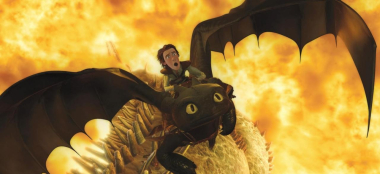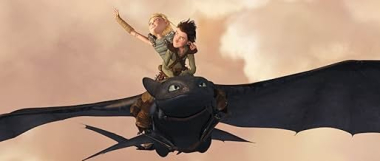How to Train Your Dragon Review
A Personal Journey Begins
From the moment I first sat down to experience How to Train Your Dragon, I found myself enveloped in an unexpectedly tender and adventurous world. This film took me back to my childhood dreams of soaring through the skies alongside fantastical creatures, yet it also offered a depth of narrative and character growth that resonated with me as an adult. I was immediately drawn into its storytelling, which transcended typical animation tropes and reinvigorated a sense of wonder in me. The film beckoned me to leave behind the familiar as I embarked on a journey rich with both mythic battles and quiet, introspective moments that connected me to the characters in a very personal way.
Diving into the World of Viking Heritage
The setting of How to Train Your Dragon is enchanted by a culture that reverberates with the echoes of a storied Viking past. As I watched, I felt as if I had been granted an exclusive peek into a world where robust traditions and rugged landscapes defined every moment of existence. The portrayal of the Viking community was layered and respectful, echoing the intricate human dramas alongside their interaction with dragons. I marveled at the balance between honor and vulnerability in the characters, where each individual embodied the spirit of both bravery and longing. The subtle nuances in the depiction of their societal norms kept me engaged while inviting me to reflect on the nature of community, identity, and the cost of change.
The Craft of Animation as an Art Form
One of the aspects that truly captivated me was the masterful art of animation. Every sequence was a work of art in its own right, blending modern techniques with a palpable sense of hand-crafted charm. I was particularly struck by the way the visuals conveyed movement and emotion, with each frame meticulously composed to evoke a specific mood. The dynamic skies, rolling hills, and intricately designed Viking settlements all contributed to an immersive experience that felt as tangible as a physical landscape. I found the fluid animation during flight sequences to be especially breathtaking, as it transformed the act of flying into a graceful dance between man and dragon. This level of detail in the artwork allowed me to lose myself in a world where every brushstroke was infused with passion and precision.
Emotional Resonance in Every Frame
Throughout the film, I experienced a spectrum of emotions that unfolded seamlessly with the narrative. Moments of quiet introspection were balanced with bursts of energy and excitement, creating a rhythm that mirrored the ups and downs of life itself. It is rare for a movie to evoke such a genuine response from its audience, but How to Train Your Dragon succeeded in doing so with every carefully crafted scene. I felt the tension, fear, and exhilaration as the characters took risks, pushing the boundaries of what they believed possible. The careful interplay between humor and heartache allowed me to celebrate small victories while also acknowledging the challenges that lay ahead. This emotional layering transformed the film from a mere animated story into a profound reflection on growth, courage, and the connections that unite us all.
The Intricacies of Dragon-Human Interaction
One of the most unforgettable parts of my viewing experience was the portrayal of the relationship between humans and dragons. The film delicately balanced the fierce unpredictability of dragons with the tender, nuanced interactions they shared with the human characters. I was completely absorbed by the way the film portrayed trust, misunderstanding, and ultimately, mutual respect. The training sequences, where tentative contact gradually evolved into a deep bond, resonated with me on multiple levels. I found parallels to real-life relationships in the way both parties had to overcome initial fears and prejudices. The narrative did not shy away from exploring conflicts and vulnerabilities, instead choosing to reveal them as opportunities for growth and understanding. This exploration provoked my own reflections about how trust is earned and how true connections thrive amid adversity.
Dynamic Storytelling and Pacing
The pacing of How to Train Your Dragon felt both measured and exhilarating, striking a balance that kept me thoroughly engaged from beginning to nearly every climax. As I witnessed the unfolding events, I appreciated how each plot twist was built upon careful character development and dramatic tension. The narrative was paced in such a way that it never rushed the emotional arcs of its cast, giving them enough time to be fully fleshed out before plunging them into new adventures. There were moments when the calm before the storm allowed me to breathe and savor the beauty of the journey, and then moments when the acceleration of the plot reminded me of the intense stakes of their endeavors. This rhythmic ebb and flow not only kept the story vibrant but also allowed me to connect with every heartbeat of the unfolding epic in a personal manner.
Soundscapes That Stir the Soul
I must also commend the sound design and musical score of the movie, which proved to be a core element of its immersive charm. Each note and sound effect was meticulously woven into the fabric of the storyline, enhancing the visual narrative in a way that felt almost magical. As I sat there listening, I was transported by sweeping orchestral themes that perfectly captured the film’s emotional highs and reflective lows. The blend of traditional instruments with modern audio techniques created an auditory experience that was both haunting and uplifting. I found that certain melodies would revisit my mind long after particular scenes had played out, echoing the emotional depth encountered on screen. The score served as a silent narrator that amplified tensions, celebrated triumphs, and underscored moments of heartfelt vulnerability.
Character Evolution and Their Depth
What truly set How to Train Your Dragon apart for me was its commitment to developing its characters with unparalleled depth. I was impressed by how each character, from the young protagonist to the wise elders of the community, was crafted with distinct personalities and realistic emotional trajectories. There was an authenticity in the way their internal struggles and transformations were portrayed, making their journeys not merely plot devices, but genuine human experiences with which I could empathize. I felt an admiration for the resilience demonstrated by the characters as they navigated their fears, aspirations, and the challenges posed by an unpredictable world. This attention to character detail rendered the narrative more impactful and allowed me to witness a tapestry of growth that was as compelling as the breathtaking action sequences that punctuated the film.
Visual Innovations and Artistic Flair
Every aspect of How to Train Your Dragon was a showcase of visual innovation that stirred my imagination. The film consistently surprised me with its creative portrayal of environments, seamlessly blending fantasy with realism. I was particularly fascinated by the intricate designs of the dragons themselves, where each creature bore a unique look that seemed to tell its own story. The use of light and shadow played a remarkable role in setting the tone for each scene, from the soft glow of early dawn over a rugged coastline to the vivid bursts of color during moments of magic and flight. As I observed the artistry behind every visual element, I felt as though I was witnessing a painter at work, each brushstroke carefully chosen to evoke wonder and mystery. This imaginative approach elevated the cinematic experience into a celebration of creativity and visual storytelling.
Immersive World-Building and Expanded Realities
As I ventured further into the narrative, I was struck by the film's dedication to world-building. Every element of the setting, from the architecture of the Viking settlements to the natural landscapes that framed each adventure, was imbued with a sense of history and culture that made the entire universe feel exceptionally tangible. I found myself mentally exploring every nook and cranny of this elaborate world, a reality that was as expansive as it was visually detailed. The creators of the film had taken care to develop a world that was not just a backdrop for the narrative, but an active participant in the unfolding drama. The lore, legends, and little-known corner stories interspersed throughout the dialogue enriched my viewing experience, compelling me to imagine the unseen lives and histories of every inhabitant of this universe. In those moments, I was not just an observer, but an active participant in an intricately constructed realm that existed beyond the limits of the screen.
Interactive Dynamics That Spark Curiosity
While watching the movie, I often felt a spark of interactivity in the way the dialogue and actions invited me to consider alternative interpretations of what was unfolding. The film did more than simply tell a story; it actively engaged my imagination by posing implicit questions and riddles about loyalty, fear, and the nature of freedom. I particularly delighted in the scenes where dialogue felt reminiscent of interactive storytelling—each choice or reaction carrying a weight that hinted at consequences beyond what was immediately shown. The dynamic between characters often felt layered with undercurrents of unspoken promises and hidden agendas, compelling me to ponder the wider implications of every interaction. This level of implicit interactivity transformed my viewing experience into an engaging puzzle, where I was constantly eager to unravel the next piece of the intricate narrative web.
An Unforgettable Adventure in Every Detail
Throughout my time with How to Train Your Dragon, I was continually surprised and delighted by the smallest details that enriched the overall narrative. Every frame, every gesture, and every carefully timed silence carried a meaning that invited deeper exploration. I was struck by how the film managed to balance grand, sweeping adventures with moments of intimate connection. The small, quiet scenes where characters share a smile or a look of mutual understanding were as memorable as the epic scenes of daring quests across stormy skies. It was within these quieter moments that I found a true appreciation for the craft behind the storytelling—every detail was meticulously thought out, contributing to a complex and layered portrayal of a world where magic and reality coexisted. The blend of these elements sparked a sense of awe in me that continued to evolve with every scene, reminding me that sometimes, it is the quieter moments that resonate most deeply within the heart.
Screenshots




Leave a comment
Your comment is awaiting moderation. We save your draft here
0 Comments